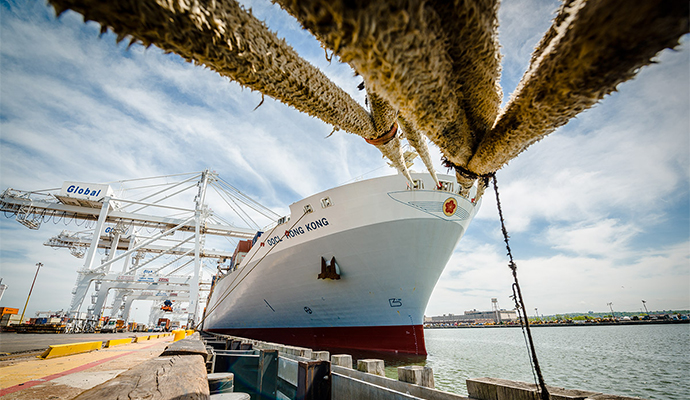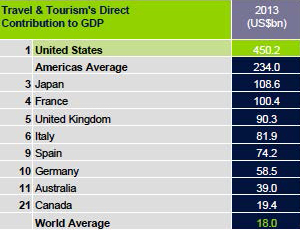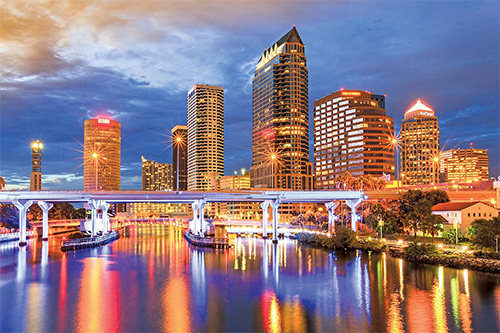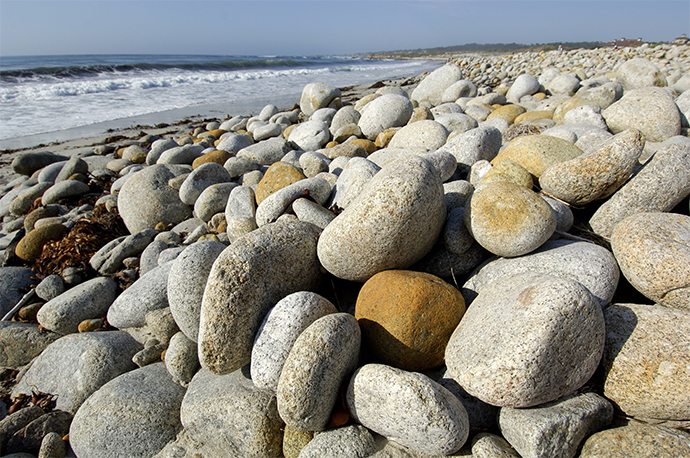
Long before the nation’s reshoring phenomenon took hold, there was an actual shoreline doing its part for the US economy. A new report says it’s still holding its own.
The National Ocean Economics Program (NOEP) of the Center for the Blue Economy, based at the Monterey Institute of International Studies in California, this week released its State of the US Ocean and Coastal Economies 2014 report, a follow-up to its initial report five years ago.
The report encompasses shoreline counties in Great Lakes states as well as ocean states. As defined by the National Oceanic and Atmospheric Administration, that means 446 counties in 30 states. In 2012, the coastal zone counties accounted for 51 percent of employment in coastal states; 42 percent of total national employment; 57 percent of GDP in coastal states; and 48 percent of national GDP.
The importance of the coastal economy is reinforced by Site Selection’s tracking of new private-sector facility investments last year, including the Eastern Seaboard and the energy-rich Gulf Coast states. As published in our traditional Governor’s Cup rankings this month, nine of the top 10 states were shoreline states. In the new per-capita category, six of the top 10 had shoreline. However, among the top 10 metro areas for projects across three separate population categories, only six of the 30 areas were shoreline communities.
In addition to measuring economic activity in the more general coastal economy, the NOEP report examined employment, wages, and output from six sectors and 21 industries whose goods and services derive in one way or another from the oceans and Great Lakes. The six sectors are marine-related construction, living resources (fisheries, seafood processing), minerals (oil and gas activity), ship and boat building, tourism and recreation, and transportation (including warehousing, deep-sea freight, passenger transport and the recently booming sub-category of search and navigation equipment).
According to the NOEP report, “four of the five largest states in terms of ocean economy employment are also the four largest states in terms of total employment. These are Texas, California, Florida, and New York. California is the only state ranked in the top five states by employment for five of the six ocean economy sectors and also in the top five in ocean economy overall. The state of Washington ranks highly among states in living resources and ship & boat building because it is the center for the Northwest Pacific fisheries.”
Tourism and recreation is the largest employment sector in the ocean economy, comprising over 1.9 million jobs or 70 percent of all marine-related employment.
The other sectors account for 65 percent of contribution to GDP but only 30 percent of employment. Minerals had the most pronounced difference, with an ocean economy GDP contribution of 33 percent but an ocean economy employment share of just 5 percent. Its average employee contribution to GDP in 2010 was $606,000, while the average tourism and recreation employee contributed $46,000 to GDP.
“From 2005 to 2010, 41,000 jobs were added to the ocean economy, but these new jobs were offset by 43,647 jobs lost in the marine construction, ship & boat building, transportation and living resources sectors,” says the report. “Overall employment over this period grew only 1.5 percent, and the tourism & recreation sector accounted for 85 percent of the new jobs.”
During that same period, the ocean economy as a whole grew by $42.4 billion, with transportation accounting for 68 percent of that growth.
Shoreline Knowledge

The report notes that while the counties along America’s ocean and Great Lakes comprise only 18 percent of the land area of the United States, they harbor 37 percent of US employment and 42 percent of total GDP.
“At 3.8 million square miles, the United States is the third largest country in the world,” says the report. “But the waters contained within the U.S. Exclusive Economic Zone [EEZ] cover an additional 1.4 million square miles, making the U.S. the country with the largest ocean area in the world, and this does not include the U.S. share of the Great Lakes.”

While that area encompasses pristine stretches of scenery and quaint small towns, the report is quick to note that it’s the shoreline’s cities that carry the bulk of the economic load. More than eight in 10 residents of coastal states live in a Metropolitan Statistical Area.
Here are some report highlights from 2010 statistics related to the ocean economy, and to the broader coastal economy:
Ocean Economy
- In terms of states, the ocean economy would be the 25th largest state by employment and the 20th largest state by GDP, the same size as Colorado.
- In terms of metropolitan areas, the ocean would be the 39th largest metropolitan area by employment, about the same size as Atlanta, and the 17th largest metropolitan area by GDP in the United States, slightly smaller than San Diego.
- In terms of industries, the ocean economy supports employment almost two and half times larger than other natural resource industries such as farming, mining, and forest harvesting, which together employed 1.15 million in 2010.
Coastal Economy
- “The coastal economy is primarily an urban economy and the distribution of economic activity along the coasts is driven significantly by forces affecting urban regions, most notably the spread of population and economic activity away from the city centers in the pattern that has come to be known as urban sprawl.”
- “The coastal economy had been the core of much of U.S. manufacturing in the past, but this has changed, and the coastal economy now produces primarily services.”
- Although employment decreased in all coastal geographies between 2007 and 2012, GDP continued to grow, albeit at a lower rate than before the recession. “Only two states (Alaska and Texas) showed employment growth in all coastal regions between 2007 and 2012, driven primarily by the oil industry,” said the report. “Two states (Louisiana and New York) had employment growth in the coastal regions and state totals, with a decline in inland county employment for the period.”
- “Between 2007 and 2012, 17 states (Alabama, Alaska, Hawaii, Indiana, Louisiana, Maryland, Massachusetts, Minnesota, New Hampshire, New York, North Carolina, Oregon, Pennsylvania, South Carolina, Texas, Virginia, and Washington) experienced GDP growth in all of the coastal regions. California and Georgia had GDP growth in shore-adjacent and coastal zone counties with declines for the state and inland GDP. Maine showed growth in its shore-adjacent counties only.”
In the 30 coastal states:
- Population was 255.8 million (82 percent of the US)
- Employment was over 107.3 million (82 percent of the US)
- GDP was $13 trillion (83 percent of the US)

In the watershed counties of the coastal states:
- Population was 162.3 million (52 percent of the US
- Employment was 67 million (51 percent of the US)
- GDP was $8.7 trillion (56 percent of the US)
In the shore-adjacent counties of the coastal states:
- Population was 116.5 million people (37 percent of the US)
- Employment was 48.8 million (37 percent of the US)
- GDP was $6.6 trillion (42 percent of US GDP)
“This is where the real concentration of economic activity occurs,” notes the report. “With 18 percent of the land area, the shore-adjacent counties account for 37 percent of the US population and 42 percent of the national economic output.” Large-economy states including California, Florida, New Jersey, Washington, Massachusetts, and Illinois have between 50 percent and 90 percent of their employment in shore-adjacent counties.

As the NOEP report indicates, metro areas drive the ocean economy. And while the Gulf Coast’s energy activity is garnering the headlines, a metro area along that coast is doing its share in other areas as well.
In the same week that the Tampa Bay Buccaneers unveiled their new logo to much fanfare, community leaders in Tampa were celebrating an announcement of even greater significance. The Atlanta-based Industrial Asset Management Council’s board of directors voted unanimously to award the Spring 2017 IAMC Professional Forum to Tampa. The decision means that about 500 high-ranking executives will descend upon Hillsborough County for five days of meaningful discussions focused on corporate real estate and economic development.
It’s welcome news to community leaders’ ears.
“All of the great things that are happening in and around Tampa are giving us great momentum right now,” says Jennifer Mikosky, communications director for the Tampa-Hillsborough Economic Development Corp. “There has been a resurgence of activity in development in downtown Tampa. We have seen the development of the Riverwalk and Curtis Hixon Park. We have launched a new mixed-use district in Channelside. A lot of commercial growth is taking place there now.”
With recent major job announcements from Amazon, Covidien, Bristol-Myers Squibb, USAA, and the Depository Trust & Clearing Corp., Tampa is on a roll. Amazon led all corporate investors in 2013 with a $204-million project, while USAA pumped $164 million into a facility investment.
Projects like these propelled Tampa to become the fastest-growing economy in Florida and 16th fastest-growing in the US last year. Tampa has also led Florida in job gains in nine of the last 10 months.
“There is no one community in America where all of the different technologies and big data are coming together into one economic eco-system,” Mikosky says. “That is what we are trying to do here in Tampa.” — Ron Starner
Population growth rate in non-shore-adjacent counties was almost twice that in shore-adjacent counties, the report notes, leading to an observation with import for site-searching executives: “The heavily developed nature of the areas near the shore means that expansion, particularly for residential development, is pushed further and further inland. At the same time, the size of the populations near the shore and the attractiveness of shoreline locations provide incentives for businesses to expand in those areas, even as the workforce commute from inland areas lengthens.”
Travel & Tourism Remains Driver
The NOEP report says the most significant long-term trend in the ocean economy is the rise of tourism & recreation as its defining sector. And that’s without even counting marine passenger transportation (which is categorized under transportation rather than tourism). It lists several reasons, including the fact that, despite declines in real income, “domestic travel and recreation has still been affordable to most people, and the oceans and Great Lakes have been a center for US vacations and leisure since the nineteenth century. The concentration of major metropolitan areas in coastal areas also contributes to the growth in components of tourism & recreation related to business travel.”
NOEP says the growing importance of tourism & recreation in the ocean economy is also supported by studies in other countries. “In France, tourism is ‘by far the largest sector of the marine and coastal economy in terms of turnover and employment’ (Kalaydjian et al. 2005). The cruise ship industry in France is not only a major part of French ocean recreation, it is also a significant part of its ship building industry; a quarter of the large cruise ships built in 2005 were built in France.”
The importance of travel and tourism was reinforced by a separately released economic impact report this week from the World Travel and Tourism Council that recognized the United States as a leader globally. The direct contribution of travel and tourism to US GDP in 2013 was $450.2 billion (2.7 percent of GDP).
“This is forecast to rise by 3.5 percent to US$465.8 billion in 2014,” said the WTTC report. A separate report on business travel released in 2011 noted that the ROI for business travel in particular is 10:1 on a global basis— that is, one unit of incremental business travel spending produces incremental industry sales of 10 units. In the Americas, the average ROI was the highest in the world, at 12:1.
“The direct contribution of travel and tourism to GDP is expected to grow by 3.7 percent [per annum] to US$671.5 billion (3 percent of GDP) by 2024,” said the newest WTTC report.

